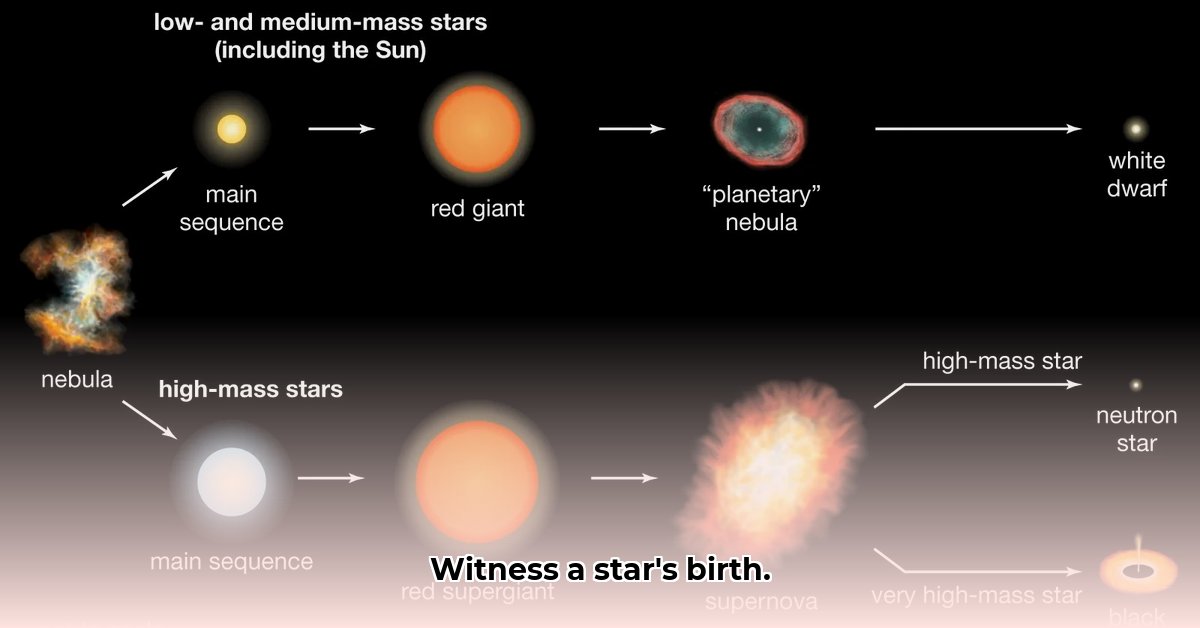Ever wondered how stars are born? It’s not some magical poof! It’s a long, slow, and incredibly powerful process that starts in giant clouds of gas and dust, swirling in the vast emptiness of space. Think of it like a cosmic snowstorm, but instead of snowflakes, it’s made of gas and dust – the raw materials for stars. Gravity, the force that keeps our feet on the ground, plays a crucial role, pulling all this material together, bit by bit, until it collapses into something amazing: a brand new star. We’ll explore this incredible process, step by step, from the initial cloud to the moment a star ignites, revealing the secrets of its early life. For more on low-mass star lifecycles, see [this page](https://braghq.com/life-stages-of-a-low-mass-star). Get ready for a cosmic adventure!
Cosmic Origins: Unveiling Star Birth
Have you ever gazed at the night sky, a canvas speckled with countless stars, and wondered about their origins? The birth of a star is a journey spanning millions of years, commencing in nebulae – cosmic nurseries far more peculiar than you might imagine. Let’s delve into the incredible story of a star’s genesis, focusing on its very first moments. How do nebulae contribute to stellar evolution, and what crucial role does gravity play in this intricate process? What are the key factors that determine a star’s ultimate fate?
Stellar Nurseries: Nebulae and the Role of Gravity
Imagine a giant, swirling cloud of gas and dust, far bigger than our entire solar system. This isn’t just any cloud; it’s a nebula, a stellar nursery brimming with the raw materials for stars. Think of it as a cosmic soup, primarily composed of hydrogen and helium, the most abundant elements in the universe. These nebulae aren’t static; they’re dynamic environments, constantly churning and shifting. Gravity, the invisible force that pulls everything together, is the fundamental player here. Within the nebula, slight variations in density occur, leading to regions where gas and dust become more concentrated.
Without gravity, these clouds would remain diffuse and scattered, never coalescing into stars. This initial clumping isn’t a rapid event; it’s a slow, gradual accumulation, similar to a snowball rolling down a hill, steadily growing larger as it gathers more snow. This gradual gathering of material under its own gravitational pull marks the very earliest stages of a star’s life. Factors like turbulence within the nebula and the presence of magnetic fields also influence this stage. The Eagle Nebula, with its famous Pillars of Creation, is a prime example of a stellar nursery where this process is actively occurring.
Protostar Formation: The Baby Star Emerges
As more and more material accumulates in these denser regions, gravity’s grip intensifies, and a protostar begins to form. Don’t picture a blazing inferno like our Sun; a protostar is more akin to a faint, warm glow, still deeply embedded within its nebula. It’s not yet shining brightly because nuclear fusion, the energy source for mature stars, hasn’t ignited. Instead, the protostar’s warmth emanates from the gravitational energy released as its mass continues to increase. Imagine compressing a giant, fluffy cloud; as it gets squeezed tighter and tighter, it starts to heat up. That’s essentially what’s happening inside a protostar.
The process of gathering material, known as accretion, is a cosmic feeding frenzy. The protostar voraciously consumes the surrounding gas and dust, gradually increasing its size, density, and temperature. During this phase, the protostar also develops powerful bipolar outflows – jets of gas ejected from its poles – which help regulate its growth and clear away surrounding material. Observations from telescopes like the Atacama Large Millimeter/submillimeter Array (ALMA) have provided detailed insights into these outflows and their impact on the surrounding nebula.
Accretion Disks: Cosmic Whirlpools Guide Growth
The infalling material doesn’t plummet directly onto the protostar. Instead, due to the conservation of angular momentum, it typically forms a swirling disk around it, resembling a cosmic whirlpool. This accretion disk is a crucial structure, acting as a regulator for the flow of material onto the protostar. Without it, the protostar might experience unstable growth or even catastrophic collapse. This slow, controlled feeding is vital for the protostar’s healthy development.
Accretion disks are complex environments, characterized by turbulence, magnetic fields, and temperature gradients. Within the disk, dust grains collide and coalesce, eventually forming larger bodies called planetesimals – the building blocks of planets. Thus, the formation of a star is intimately linked to the formation of planetary systems. Scientists continue to explore the intricate dynamics of accretion disks through both observations and computer simulations, seeking to unravel the mysteries of planet formation.
Nuclear Fusion: The Ignition of a Star
After millions, sometimes tens of millions, of years of gradual growth and heating, a pivotal event occurs. The pressure and temperature at the protostar’s core reach a critical threshold, triggering nuclear fusion. Hydrogen nuclei (protons) begin to fuse together, forming helium nuclei and releasing an immense amount of energy in the process, following Einstein’s famous equation E=mc². This marks the moment when a protostar transforms into a true star, a self-sustaining nuclear furnace.
The faint glow of the protostar is now superseded by a brilliant shine, a beacon of light in the vastness of space. The star embarks on its main sequence phase, a relatively stable period where it will spend the majority of its life, calmly converting hydrogen into helium and radiating energy into the universe. The star’s mass profoundly influences its characteristics during this phase; more massive stars burn hotter and brighter but have significantly shorter lifespans, while less massive stars burn cooler and dimmer, with lifespans that can extend for trillions of years.
Star Mass: Shaping the Stellar Lifecycle
The initial mass of a protostar is the primary determinant of its entire life cycle, dictating its luminosity, temperature, lifespan, and eventual fate. However, other factors also play significant roles in shaping stellar evolution:
- Binary and Multiple Star Systems: Binary star systems, in which two stars orbit each other, are surprisingly common, comprising at least half of all star systems. The gravitational interactions between the stars in these systems can dramatically alter their stellar evolution compared to solitary stars, leading to phenomena such as mass transfer and tidal distortion.
- Magnetic Fields: Magnetic fields play a crucial role in regulating the flow of material onto the protostar, influencing the structure of the accretion disk and the dynamics of the bipolar outflows. The strength and configuration of the magnetic field can affect how material falls onto the protostar, influencing its rotation rate and the distribution of mass within the star.
- Metallicity: The abundance of elements heavier than hydrogen and helium, collectively known as metallicity, in the protostar’s initial composition can also influence its evolution. Higher metallicity can affect the star’s opacity, its energy transport mechanisms, and its ability to form planets.
- Low-Mass Protostar Formation: The formation of low-mass protostars is a particularly complex, multi-stage process. These stars often form in dense molecular cloud cores, where they compete for resources with other forming stars. The process can be influenced by factors such as turbulence, magnetic fields, and radiative feedback from nearby stars
The following table illustrates how star mass affects its approximate main sequence lifetime:
| Star Mass (compared to our Sun) | Approximate Main Sequence Lifetime |
|---|---|
| 0.1 times the Sun’s Mass | Trillions of years |
| 0.5 times the Sun’s Mass | 56 Billion years |
| Same as the Sun’s Mass | 10 Billion years |
| 2 times the Sun’s Mass | 2 Billion years |
| 10 times the Sun’s Mass | 20 Million years |
| 50 times the Sun’s Mass | 1 Million years |
This table vividly illustrates that the most massive stars live fast and die young, while smaller stars lead more leisurely lives, burning their fuel at a much slower rate.
The journey from a tenuous cloud of gas and dust to a blazing star is a breathtaking testament to the power of nature’s laws. While we have made significant progress in understanding star formation, numerous unanswered questions still linger about stellar nurseries and protostar evolution. What role does turbulence play in regulating star formation? How do magnetic fields influence the fragmentation of molecular clouds? How do protostars interact with their surrounding environments?
We’ve only scratched the surface of the earliest stages of a star’s life, but this initial phase holds the key to understanding the entire cosmic drama that unfolds over billions of years. As new observations are made with increasingly powerful telescopes and as our theoretical models become more sophisticated, we are constantly refining our understanding of these fundamental processes. The universe is vast and complex, filled with unanswered questions, and the story of star formation is a continuing saga, unfolding before our very eyes.
- Major Lyric Contest Opens Doors for Aspiring Songwriters - December 14, 2025
- American Song Contest 2025 Invites Songwriters To Impress Industry Experts - December 13, 2025
- Song Contest USA Faces Challenges To Find National Success - December 12, 2025










